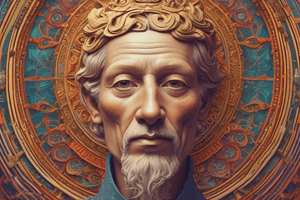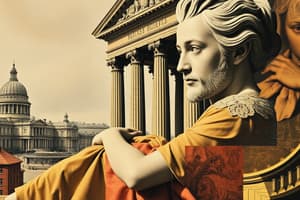Podcast
Questions and Answers
Which of the following characteristics best describes the core intellectual focus of the Enlightenment?
Which of the following characteristics best describes the core intellectual focus of the Enlightenment?
- Prioritizing learning, reason, and societal progress. (correct)
- Focus on mortality and the afterlife.
- A leaning towards traditional customs and established hierarchies.
- Emphasis on emotion, individuality, and the supernatural.
What role did coffee houses primarily play during the Enlightenment period?
What role did coffee houses primarily play during the Enlightenment period?
- Exclusively social venues for the upper class.
- Hubs for intellectual discussion and inspiration. (correct)
- Locations for conducting clandestine political activities.
- Centers for religious sermons and theological debates.
Which of the following is a key characteristic of the novel's rise during the Enlightenment?
Which of the following is a key characteristic of the novel's rise during the Enlightenment?
- Exclusively upper-class characters set in distant lands.
- Focus on mythological and legendary characters.
- Heavy reliance on complex symbolism and abstract themes.
- Depiction of realistic, middle-class characters and situations. (correct)
Which literary device was predominantly employed to critique societal flaws during the Enlightenment?
Which literary device was predominantly employed to critique societal flaws during the Enlightenment?
What element primarily fueled the shift from the Enlightenment to Romanticism?
What element primarily fueled the shift from the Enlightenment to Romanticism?
Which characteristic is least associated with the Romantic novel?
Which characteristic is least associated with the Romantic novel?
How did Romanticism poets view nature?
How did Romanticism poets view nature?
Which of the following themes became prominent in Romanticism?
Which of the following themes became prominent in Romanticism?
What significant historical event directly contributed to the Victorian Era's societal structure and expansion?
What significant historical event directly contributed to the Victorian Era's societal structure and expansion?
Which writer critiqued formal institutions and praised imagination in works such as Songs of Innocence and Songs of Experience?
Which writer critiqued formal institutions and praised imagination in works such as Songs of Innocence and Songs of Experience?
What was a major social impact of the scientific and technological advancements that occurred during the Victorian Era?
What was a major social impact of the scientific and technological advancements that occurred during the Victorian Era?
The phrase 'large, loose, baggy monsters,' used to describe Victorian novels, refers to which defining characteristic?
The phrase 'large, loose, baggy monsters,' used to describe Victorian novels, refers to which defining characteristic?
Which author is best known for their contribution to the historical novel during the Romantic period?
Which author is best known for their contribution to the historical novel during the Romantic period?
Which of the following best describes 'Victorian gloom' as depicted in the era's literature?
Which of the following best describes 'Victorian gloom' as depicted in the era's literature?
What literary movement emerged in Late Victorianism as a darker, more cynical evolution of realism?
What literary movement emerged in Late Victorianism as a darker, more cynical evolution of realism?
How did the First Reform Act of 1832 contribute to the sociopolitical landscape of the Victorian Era?
How did the First Reform Act of 1832 contribute to the sociopolitical landscape of the Victorian Era?
Flashcards
Enlightenment
Enlightenment
An 18th-century intellectual movement emphasizing reason and progress.
Rationality
Rationality
The quality of being based on or guided by reason or logic.
Empiricism
Empiricism
The theory that knowledge originates from experience and observation.
Deism
Deism
Signup and view all the flashcards
Satire
Satire
Signup and view all the flashcards
Romanticism
Romanticism
Signup and view all the flashcards
Lake Poets
Lake Poets
Signup and view all the flashcards
The Supernatural
The Supernatural
Signup and view all the flashcards
Victorian Era
Victorian Era
Signup and view all the flashcards
Victorian Poetry
Victorian Poetry
Signup and view all the flashcards
Dramatic Monologue
Dramatic Monologue
Signup and view all the flashcards
The Woman Question
The Woman Question
Signup and view all the flashcards
Naturalism
Naturalism
Signup and view all the flashcards
Historical Novel
Historical Novel
Signup and view all the flashcards
Victorian Gloom
Victorian Gloom
Signup and view all the flashcards
Study Notes
The Enlightenment (18th Century)
- Intellectual movement emphasizing reason, learning, and societal progress.
- Also known as the Age of Reason and the Age of Improvement.
- Key characteristics: rationality, empiricism (knowledge from experience), deism (belief in a non-intervening Creator).
- Light symbolized knowledge and education.
- Key figures: philosophers Locke, Hume, and Smith; scientists Newton and Priestley; poets Pope and Swift; novelists Defoe, Richardson, and Fielding.
- Flourishing of journalism; coffee houses as discussion hubs.
- Satire, a dominant literary form, critiqued societal flaws.
- Examples of satirical works include A Modest Proposal by Swift and The Beggar's Opera by Gay.
- Rise of the novel, influenced by journalism, diaries, and travel accounts.
- Depicted realistic middle-class characters.
- Examples include Robinson Crusoe by Defoe and Pamela by Richardson.
Shift to Romanticism (Mid-18th Century)
- Reaction against Enlightenment rationality.
- A shift from light to imagination, emotion, and darkness.
- Influenced by Graveyard School poetry (focusing on mortality and the afterlife) and the Gothic novel (emphasizing mystery, terror, and the supernatural).
- Key figures: Thomas Gray, Robert Blair (Graveyard School); Horace Walpole, Ann Radcliffe (Gothic).
Romanticism (Late 18th–Early 19th Century)
- Reaction against Enlightenment rationalism.
- Emphasized emotion, individuality, nature, and the supernatural.
- Influenced by the French Revolution.
- Key figures & themes: Pre-Romanticism (William Blake, critiquing institutions and praising imagination); First-generation Romantic poets (Lake Poets - Wordsworth, Coleridge); Second-generation Romantics (Keats, Shelley, Byron).
- Major themes: Nature as a source of emotion and inspiration; supernatural elements in dreams, visions, nightmares; the human condition, including political, social, and economic critiques.
- Examples of Romantic works: The Rime of the Ancient Mariner (Coleridge), La Belle Dame Sans Merci (Keats).
- Genres include the historical novel (Walter Scott, Waverley), the novel of manners (Jane Austen, exploring social customs), and the Romantic Gothic novel (Mary Shelley, Frankenstein), incorporating dark settings and psychological depth.
The Victorian Era (19th Century)
- Historical background: Queen Victoria's reign, industrialization, urbanization, and British Empire expansion.
- Stratified society with rigid class divisions.
- Scientific and technological advancements (steam engine, railways, telegraph).
- Victorian morality emphasized discipline, modesty, and rigid gender roles.
- Notable events: First Reform Act (1832) expanded voting rights.
- Poetry took a secondary role to the novel, with themes of individual emotion, domestic life, imperialism, and dramatic monologue.
- Key figures: Tennyson, Browning.
- Themes: medievalism, Victorian gloom (Arnold, Dover Beach).
Victorian Novel
- "Large, loose, baggy monsters" – long, complex, often serialized stories.
- Focused on realism and social issues, addressing industrialization, class mobility, crime, and gender roles.
- "The Woman Question" – debate over women's roles (angel in the house vs. feminism).
- Key figures: Dickens (social criticism, melodrama); Brontës (challenging gender roles); George Eliot (moral essays); Hardy (tragic realism).
Late Victorianism
- Literature became darker, more experimental, and moving away from strict Victorian ideals.
- Genres emerged like Naturalism (grittier realism, e.g., New Grub Street by Gissing), fantasy, and science fiction (e.g., Alice's Adventures in Wonderland, The Time Machine).
- Social Darwinism influenced literature, questioning survival, evolution, and class structures.
Studying That Suits You
Use AI to generate personalized quizzes and flashcards to suit your learning preferences.
Description
Explore the significant intellectual movement of the Enlightenment in the 18th century, highlighting its emphasis on reason, learning, and societal improvement. Discover key philosophers and works that defined this era, as well as the transition to Romanticism, which served as a reaction to Enlightenment ideals. This quiz provides insights into the key figures, literary forms, and societal impacts of these two pivotal movements.




